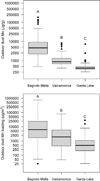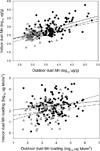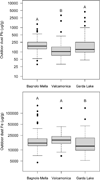Impact of ferromanganese alloy plants on household dust manganese levels: implications for childhood exposure
- PMID: 25747819
- PMCID: PMC4385503
- DOI: 10.1016/j.envres.2015.01.019
Impact of ferromanganese alloy plants on household dust manganese levels: implications for childhood exposure
Abstract
Adolescents living in communities with ferromanganese alloy plant activity have been shown to exhibit deficits in olfactory and fine motor function. Household dust may serve as an important manganese (Mn) exposure pathway to children, though dust Mn concentrations have not previously been measured to assess household contamination from ferromanganese alloy plant emissions. Here we determined the association between dust concentrations and surface loadings of Mn and other metals (Al, Cd, Cr, Cu, Fe, Pb, and Zn) in indoor and outdoor household dust from three Italian communities that differ by history of ferromanganese alloy plant activity: Bagnolo Mella, with an active ferromanganese alloy plant (n=178 households); Valcamonica, with historically active plants (n=166); and Garda Lake, with no history of ferromanganese plant activity (n=99). We also evaluated Mn levels in other environmental (soil, airborne particulates) and candidate biomarker (blood, hair, saliva, fingernails) samples from children within the households. Household dust Mn concentrations and surface loadings were significantly different between the three sites, with levels highest in Bagnolo Mella (outdoor median Mn concentration=4620, range 487-183,000µg/g), intermediate in Valcamonica (median=876, range 407-8240µg/g), and lowest in Garda Lake (median=407, range 258-7240µg/g). Outdoor dust Mn concentrations in Bagnolo Mella, but not the other communities, were significantly inversely related with distance from the plant (R(2)=0.6630, P<0.0001). Moreover, outdoor dust Mn concentrations and loadings were highly predictive of but significantly higher than indoor dust Mn concentrations and loadings by ~2 to ~7-fold (Mn concentrations) and ~7 to ~20-fold (Mn loadings). Finally, both indoor and outdoor dust Mn concentrations and outdoor dust Mn loading values were highly significantly correlated with both soil and air Mn concentrations, and with children's hair and fingernail Mn concentrations, but weakly or not associated with saliva or blood Mn levels. Given the evidence associating elevated Mn exposure with neurological impairments in children, these data support that dust Mn levels should be reduced in contaminated environments to protect the health of resident children.
Keywords: Biomarker; Dust; Exposure; Ferroalloy; Manganese.
Copyright © 2015 Elsevier Inc. All rights reserved.
Figures






References
-
- Agency for Toxic Substances and Disease Registry. Toxicological Profile for Manganese. Atlanta: U.S. Department of Health and Human Services; 2012. - PubMed
-
- Al-Awadhi JM, AlShuabi AA. Dust fallout in Kuwait city: Deposition and characterization. Sci. Total. Environ. 2013;461–462:139–148. - PubMed
-
- Al-Khashman OA. The Investigation of metal concentrations in street dust samples in Aqaba city, Jordan. Environ. Geochem. Hlth. 2007;29:197–207. - PubMed
-
- Allott RW, Kelly M, Hewitt CN. A model of environmental behaviour of contaminated dust and its application to determining dust fluxes and residence times. Atmos. Environ. 1994;28:679–687.
-
- Aschner M, Erikson K, Dorman D. Manganese Dosimetry: Species Differences and Implications for Neurotoxicity. Cr. Rev. Toxicol. 2005;35:1–32. - PubMed
Publication types
MeSH terms
Substances
Grants and funding
LinkOut - more resources
Full Text Sources
Other Literature Sources
Medical

